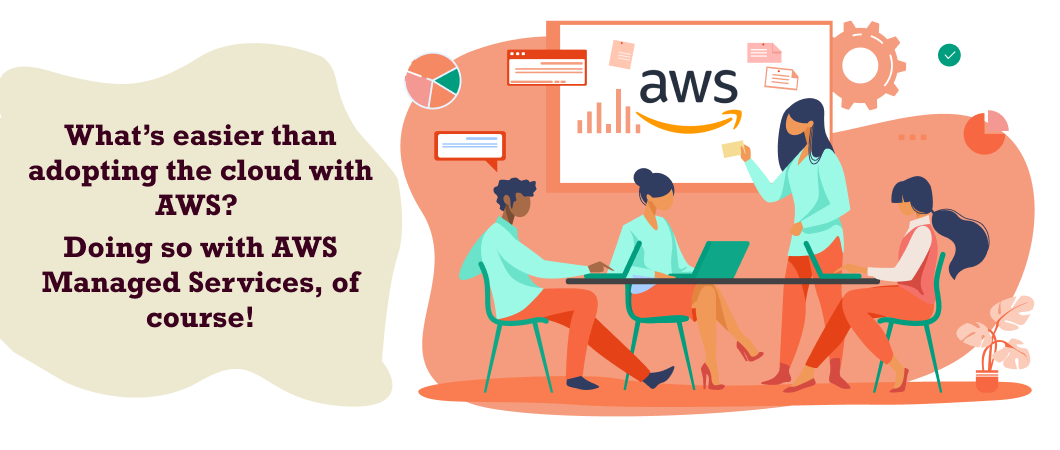According to a study by Synergy Research Group, Amazon’s cloud infrastructure was leading the market in Q4 2020 with 32-33% worldwide market share.
Indeed, cloud architecture is driving flexibility and agility of all enterprises in the post-pandemic era. More than 92% of companies conduct at least some part of their IT operations via the cloud.
A Google-commissioned study by IDG found that 85% of IT leaders trust the infrastructure security of cloud computing.
To keep up with this changing tech-scape, many businesses now opt for microservices that make implementations smoother. Favorably, cloud providers have parted ways with on-premise server maintenance costs and offer services at minimal configuration and settings. These are called managed services.
Statistically, Amazon Web Services (AWS) Managed Services are the most popular.
AWS Managed Services – What Are They?
AWS Managed Services (AMS) is an Amazon service that manages the operation of different components in the AWS infrastructure. AMS ensures that the cloud services are easily accessible and affordable for maximum users. It also contributes to faster operations, providing an easy way to migrate on-premises data to the cloud.
Essentially, AMS deals with updates, security, continuity management, backup services, patch release, and sends response requests. With AMS, companies can reduce operational overhead and risk by choosing their unique approach toward cloud development.
Benefits of AWS Managed Services
AWS Managed Services offer 24×7 customer support, all year round, with robust servicing for all their products. When companies opt for AMS, they also get into a healthy framework of workflow and servers. In that light, there are multiple benefits of AMS.
Reduction in Operational Cost
Irrespective of the size of an organization, everyone looks for cost-reduction opportunities so that the savings can be better utilized.
The task of infrastructure management and hiring specialized skill sets to operate it can be challenging for small and medium businesses.
For simpler networks, AMS is the easiest choice, with shorter downtimes. It is extremely affordable in comparison to an in-house IT department and serves all the same purposes.
Cost Estimation
With AMS, it’s easy to get a cost estimation on the services that organizations use. They receive a consistent monthly bill, thus, taking out the likelihood of something unexpected happening.
As businesses add new features and services, the bill is modified accordingly. But in every situation, the company has accurate cost estimation in advance.
Scalability and Flexibility
In 2022, it isn’t easy to gauge how successful an endeavor can get. This is why companies demand flexible options that they can modify and manage per their needs.
AMS offers scalable solutions for businesses of all sizes. It allows different payment plans according to the needs, allowing companies to downgrade or upgrade immediately.
Compliance
AMS is progressively working towards meeting the compliance requirements of enterprises. They have acquired compliance attestation and certification against SOC 1, 2, and 3, ISO, GDPR, HIPAA, PCI-DSS, and HITRUST.
Several workloads demand FedRAMP moderate, and AMS guarantees pre-authorization to operate that too.
Quick Response and Remediation
AWS Managed Services connect trained technicians with enterprises to answer all of their queries. From optimizing AWS cloud costs to monitoring the status of the infrastructure, a specialist is always available to support the businesses with a quick response time.
Crisis Management
When companies depend entirely on the cloud, one slight mishap can cost all vital data. Therefore, it’s critical to have constant backup options to protect the cloud-based services from such disasters and make data accessible even during crises.
AMS comes with disaster recovery solutions to assist with backups and redundancy. This way, enterprises have ample resources to fall back on, despite ongoing crises.
Security
Amazon claims to have 150+ managed guardrails and security checks to the managed AWS services. It ensures AWS best practices utilizing multiple AWS native tooling. It also takes preventative measures like creating redundancy and taking backups.
The detective controls and security measures of managed AWS services are unbeatable and aligned with NIST.
Types of AWS Managed Services
The three main types of managed cloud services that AWS offers are:
AWS Managed Services Accelerate
This plan enhances a team’s potential to manage AWS workloads. As per the enterprise’s long-term goals and needs, they can choose the level of operational support they need.
AWS Managed Services Advanced
Meant for a more professional environment, this plan supports preventative maintenance through a change management system within the AWS-managed landing zone. It restricts some AWS flexibility to offer better security to critical business applications. The advanced plan also allows for IT service management integration and account operations.
AWS Managed Services Operations on Demand
This plan is for businesses that require one-time or recurring access to additional AMS features and skills. There is a curated catalog of operations, and enterprises can choose the use cases per their requirements.
AWS Managed Services List
AWS Managed Services (AMS) offer a comprehensive suite of solutions designed to address various operational challenges in cloud computing. Whether you need assistance with monitoring, security, or cost optimization, AWS Managed Services provides the following key offerings:
- Service Desk: Responsive support for addressing user inquiries and issues promptly.
- Operational Monitoring: Continuous monitoring of AWS infrastructure and applications to ensure performance and reliability.
- Backup Management: Automated and managed backups to safeguard data integrity and availability.
- Cost Optimization: Strategies and tools to minimize AWS usage costs without compromising performance.
- Logging: Centralized logging to track and analyze AWS service usage and performance metrics.
- Reporting: Customizable reports for visibility into AWS resource utilization and operational insights.
- Service Delivery: Reliable delivery of AWS services with guaranteed SLAs and operational excellence.
- Access Management: Secure management of user access to AWS resources with role-based permissions.
AWS Managed Services also include:
- Patching: Automated patch management to keep AWS environments secure and up to date.
- Security Management: Implementation of security best practices and compliance frameworks to protect AWS environments.
- Curated Catalog: Pre-vetted AWS services and solutions tailored to enterprise needs.
- Operational Expertise: Access to AWS-certified experts for guidance and support.
- Pay For What You Use: Cost-effective pricing model based on actual AWS resource consumption.
How To Leverage AWS Managed Services?
To leverage the full potential of AMS, businesses need assistance from AWS Managed Service providers. They ensure that the company has ample cloud infrastructure to support its growth and make the best cloud computing choices. With their wide range of consultation and implementation services, businesses can quickly and successfully realize their goals.
Experts at Forgeahead can help businesses migrate their applications to the cloud and run AWS cloud infrastructure while keeping operational costs low. We aim to reduce the complexity of cloud computing for you to deliver excellent services to your customers. Learn more about our services here!
FAQ
How does AWS Managed Services handle security?
AWS Managed Services incorporates security best practices directly into its services. It includes automated security patching, vulnerability scanning, and proactive threat detection. AWS follows a shared responsibility model, where AWS manages security of the cloud, while customers are responsible for security in the cloud.
What types of workloads can benefit from AWS Managed Services?
AWS Managed Services is designed to support a wide range of workloads, from development and testing environments to production applications and enterprise-grade workloads. It can handle both traditional and cloud-native architectures.
Can AWS Managed Services integrate with existing AWS accounts?
Yes, AWS Managed Services can integrate with your existing AWS accounts. It helps manage multiple AWS accounts under a single AMS environment, providing centralized governance and oversight while maintaining isolation between environments.
Does AWS Managed Services offer support for hybrid cloud environments?
Yes, AWS Managed Services supports hybrid cloud environments by integrating with on-premises infrastructure and other cloud providers. It facilitates a consistent operational model across your hybrid IT landscape.
What level of control do customers have over their AWS environment with AWS Managed Services?
Customers retain full administrative control over their AWS accounts and resources. AWS Managed Services enhances operational control by providing managed services for routine tasks, allowing customers to focus on strategic initiatives and application development.
How is data backup managed in AWS Managed Services?
AWS Managed Services includes automated backup capabilities for essential services and data. It ensures data durability and provides options for backup retention policies based on your compliance and business requirements.



